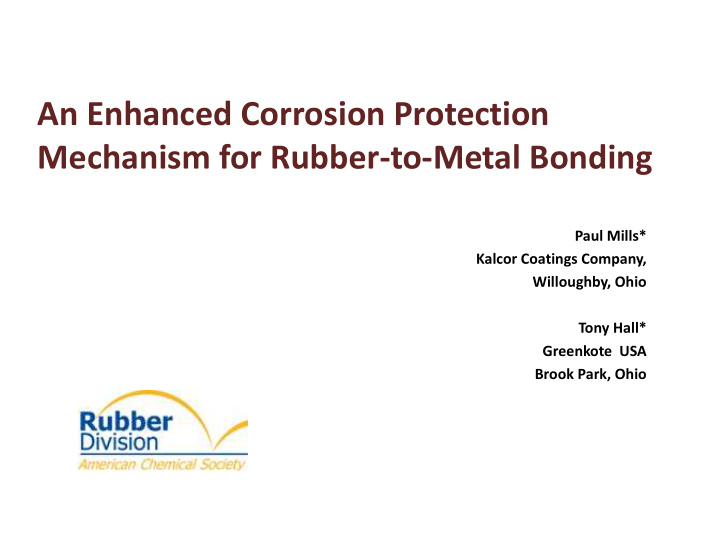



An Enhanced Corrosion Protection Mechanism for Rubber-to-Metal Bonding Paul Mills* Kalcor Coatings Company, Willoughby, Ohio Tony Hall* Greenkote USA Brook Park, Ohio
Outline 1. Motivation 2. Solution 3. The TCSM Coating Process 4. The Waterborne Coating Process 5. Test Results 6. Conclusions & Future Direction
1. Motivation • Standards are becoming more stringent – Corrosion protection to 1,000 + hours – “Cosmetic Corrosion” is unacceptable – Dynamic properties demand improved bond performance • Process variability within conventional processes • Flexible processes for cost containment opportunities • Compliance to environmental standards • Thermal-Diffusion plus Waterborne coating provides functional and cosmetic properties
2. Proposed Solution • Two-Stage Process – Thermo-Chemical Surface Modification ( TCSM) – Waterborne high corrosion paint
2. Proposed Solution • Better Corrosion Resistance: – > 1500 hours of salt spray corrosion resistance – Long Term under bond corrosion protection – Inhibits Galvanic Cell Activity • Better Bond Performance: – Initial Bond Strength – Bond Strength Retention – Compatible with industry recognized adhesive coatings • Better Environment, Health & Safety: – No Chrome III or Chrome VI – Eco-Friendly processes configured to customer requirements
TCSM Applications Substrates Components • • Suspension Bushings Stampings • • Engine Mounts Fasteners • • Exhaust Hangers Sintered Metal & MIM Shapes • • Chassis Mounts Forgings • • Mass Dampers Ductile Iron Castings • • Strut Mounts Formed Tubes • • Seals Bars & Pipe
3. Thermo Diffusion Coatings Patented zinc/aluminum protective formulations used as a base coat for automotive and industrial Duplex Coatings. • Dry bulk powder • No VOC’s or out gassing bi -products • Do not contain Chrome III or Chrome VI • Does not cause Hydrogen Embrittlement • Complies with RoHS and ELV Directive (2000/53EC)
First Stage TCSM
Second Stage TCSM
Result: TCSM
TCSM - Micrographs
TCSM Coating Process 1.Degrease Parts 2.Apply 5.Dry TCSM Parts Coating 4.Ambient 3.Powder Water Separation Rinse
4. Waterborne Coating Step • Low VOC corrosion resistance polymer coating – Excellent adhesion to metals and rubber formulations – Low moisture and permeability properties – Air dry or low bake temperatures for accelerated dry time – Variable film thicknesses applied by spray or dip systems – Can be formulated for colors with gloss levels up to 35 • Enhanced corrosion performance when used with TCSM • Cost effective alternative for electro-deposition coatings when applied to RTM components and sub assemblies
Waterborne Paint Application Dip, or Dip-Spin Spray Painting
Waterborne Coating Specifications Product Name Kalgard 094 – water reducible coating #94-9218JB Solids 54% 2% by weight, 37% 2% by volume VOC 0.5 lbs/gallon theoretical Weight/Gallon 11.12 0.2 lbs / gallon Viscosity 35 2 seconds, #2 Zahn 205 o F Flash Point 2 – 8 @60 o Gloss pH 5.5 – 6.5 Coverage 303 sq. ft. / gallon @ 2.0 mil DFT Salt Spray 500+ hours ASTM B117 Humidity 480+ hours ASTM D2247 Gravelometer Pass, SAE J-400 Chemical Resistance 50/50 Ethylene Glycol, Excellent 10w30 Engine Oil @275 o F @ 1 hour, Excellent Gasoline 70 o F @ 1 hour, Excellent Brake Fluid 70 o F @ 1 hour, Excellent Self Life 6 months maximum @ 70 o F 30 minutes @ 75 o F @ 50% RH to Touch Cure Schedule 45 minutes @ 75 o F @ 50% RH to Handle 4 hours @ 75 o F @ 50% RH to Recoat Application Spray (air, airless, electrostatic), dip, dip spin, brush touch-up Clean-up While plastic: warm detergent water, after cure: MEK
5. Test Results: Phosphate vs. TCSM with Adhesive Cover Coat 1,000 hours Salt Fog Testing ASTM B117
500 hours vs. 1,000 hours corrosion results Scribe Creep (mm) Blistering Unscribed Area Treatment 500 h 1000 h 500 h 1000 h 500 h 1000 h Greenkote PM-1 0 0 none none No failure No failure Greenkote PM-10 0 0 none none No failure No failure Zinc Phosphate 0.1 mm > 16 mm none several No failure 5% Failure
500 hours vs. 1,000 hours bond strength Initial Bond Strength 1000 Hours Salt Spray Treatment Pounds Std. Dev. Pounds Std. Dev. % Change Greenkote PM-1 1150.0 18.9 972.7 25.5 -15.42% Greenkote PM-10 1193.3 35.3 978.0 72.2 -18.04% Zinc Phosphate 939.9 104.8 252.3 253.5 -73.16% Improvement (w/PM-1) +22.35% + 285.5%
500 hours vs. 1,000 hours bond strength (2) Initial Bond Strength 1000 Hours Salt Spray % Treatment Newtons Std. Dev. Newtons Std. Dev. Change Greenkote PM-1 6831.5 169.49 6138.0 276.6 -10.15% Zinc Phosphate 5613.0 1971.0 3165.0 1858.0 -43.61% Improvement + 21.71% + 93.93%
TCSM with and without top coating 1500 + hours Salt Fog Exposure – ASTM B117 TCSM + Waterborne Top Coat TCSM only
TCSM and Waterborne Coating 2,000 hours Salt Fog Exposure ASTM B117
Process Testing on RTM Bonding Parts
6. Conclusions • Improved Bond Performance with TCSM coatings – TCSM provides superior anchor sites for primer and adhesive topcoats. – Initial Bond Strength improved 20%-30% – Bond Strength retention exceeds 75% of original values after 1000 hours of Salt Fog exposure. No under bond corrosion failures reported. – The coating performs well in post forming assembly operations for crimping, swaging, and bending.
6. Conclusions (cont’d) • Existing systems are challenged to meet the latest cosmetic, performance and environmental requirements but the proposed process does. • Improved Corrosion Resistance – TCSM + Waterborne coating tested beyond 1,500 hours of Salt Fog Exposure • Improved Environmental Compliance – No Chrome III or Chrome VI – Minimal process waste stream • The new system is more user friendly. – TCSM + Waterborne coating process can be added to manufacturing operations for RTM components and assemblies
Thank You ! Tony Hall Greenkote USA Phone: 216-410-1021 E-mail: Tony.Hall@greenkote.com www:greenkote.com Paul Mills Kalcor Coatings Company Phone: 440-570-5228 E-mail: pmillsoh@aol.com www.kalcor.com
Recommend
More recommend